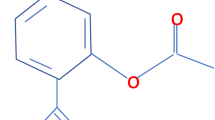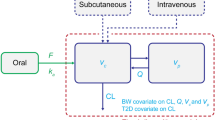Abstract
Purpose. The objectives of this study are to determine the plasma distribution of free and chylomicron-associated BIRT 377 within rats and rabbits.
Methods. For the rat studies free and chylomicron-associated BIRT 377 was incubated in plasma from CD 1 non-fasted rats for 60 minutes at 37°C. Following incubation the plasma was separated into its lipoprotein and lipoprotein-deficient plasma (LPDP) fractions by three different methods and analyzed for BIRT 377 content by HPLC. For the rabbit studies New Zealand fasted white rabbits (3 kg; n = 4) were administered an intravenous dose of free BIRT 377 (1 mg/kg). Following administration, serial blood samples were obtained and the plasma was analyzed for BIRT 377. The plasma collected at the 0.083-h time point was separated into each of its lipoprotein fractions and analyzed for BIRT 377.
Results. 37.8 ± 1.2% of the original drug amount incubated in rat plasma was recovered within the lipoprotein-rich fraction. 41.5 ± 0.4% of the original chylomicron-associated drug concentration incubated was recovered within the lipoprotein-rich fraction. The percentage of drug recovered within the TRL fraction was significantly greater following the incubation of chylomicron-associated BIRT 377 compared to free BIRT 377. In addition, BIRT 377 apparently follows a two-compartment pharmacokinetic model following single intravenous dose administration to rabbits.
Conclusions. These findings suggest that plasma lipoprotein binding of BIRT 377 is evident and may be a factor in evaluating the pharmacological fate of this drug when administered to patients that exhibit changes in their plasma lipoprotein lipid.
Similar content being viewed by others
REFERENCES
K. M. Wasan and S. M. Cassidy. Role of Plasma Lipoproteins in Modifying the Biological Activity of Hydrophobic Drugs. J. Pharm. Sci. 87:411-424 (1998).
R. A. Davis and J. E. Vance. Structure, assembly and secretion of lipoproteins. In D. E. Vance and J. E. Vance (eds.), Biochemistry of Lipids, Lipoproteins and Membranes, Elsevier, New York, 1996 pp. 473-493.
M. Le Maire and J. P. Tillement. Role of lipoproteins and erythrocytes in the in vitro binding and distribution of cyclosporin A in the blood. J. Pharm. Pharmacol. 34:715-718 (1982).
R. F. Aten, T. R. Kolodecik, and H. R. Behrman. Ovarian vitamin E accumulation: Evidence for a role of lipoproteins. Endocrinology 135:533-539 (1994).
T. A. Ho Ngoc-Ta and G. Sirois. Quinidine and propanolol binding to very low and low-density lipoproteins of human plasma. Can. J. Phys. Pharmacol. 62:589-595 (1984).
J. Oravcova, D. Sojkova, N. Fetkovska, and T. Trnovec. Factors influencing isradipine and amlodipine binding to human plasma lipoproteins. Blood Pressure 1(S):61-64 (1994).
Y. Ridente, J. Aubard, and J. Bolard. Absence in amphotericin B-spiked human plasma of the free monomeric drug, as detected by SERS. FEBS Letters 446:283-286 (1999).
K. M. Wasan, M. Ramaswamy, M. P. McIntosh, C. J. H. Porter, and W. N. Charman. Differences in the lipoprotein distribution of halofantrine are regulated by lipoprotein apolar lipid and protein concentration and lipid transfer protein I activity: In vitro studies in normolipidemic and dyslipidemic human plasmas. J. Pharm. Sci. 88:185-190 (1999).
E. Pike, B. Skuterud, P. Kierulf, and P. K. Lunde. Significance of lipoproteins in serum binding variations of amitriptyline, nortriptyline and quinidine. Clin. Pharm. Ther. 32:599-606 (1982).
K. M. Wasan and J. S. Conklin. Enhanced amphotericin B nephrotoxicity in intensive care patients with elevated levels of low-density lipoprotein cholesterol. Clin. Infect. Dis. 24:78-80 (1997).
K. M. Wasan, G. A. Brazeau, A. Keyhani, A. C. Hayman, and G. Lopez-Berestein. Role of liposome composition and temperature in distribution of amphotericin B in serum lipoproteins. Antimicrob. Agents Chemother. 37:246-250 (1993).
J. Brajtburg, S. Elberg, J. Bolard, and G. Medoff. Interaction of plasma proteins and lipoproteins with amphotericin B. J. Infect. Dis. 149:986-992 (1984).
K. M. Wasan, R. E. Morton, M. G. Rosenblum, and G. Lopez-Berestein. Decreased toxicity of liposomal amphotericin B due to association of amphotericin B with high density lipoproteins: Role of lipid transfer protein. J. Pharm. Sci. 83:1006-1010 (1994).
C. Grunfeld, M. Pang, W. Doerrler, J. K. Shigenaga, P. Jensen, and K. R. Feingold. Lipids, lipoproteins, triglyceride clearance and cytokines in human immunodeficiency virus infection and the acquired immunodeficiency syndrome. J. Clin. Endocrinology Metab. 74:2045-2051 (1992).
K R. Feingold, R. M. Krauss, M. Pang, W. Doerrler, P. Jensen, and C. Grunfeld. The hypertriglyceridemia of acquired immunodeficiency syndrome is associated with an increased prevalence of low density lipoprotein subclass pattern B. J. Clin. Endocrinology Metab. 76:1423-1431 (1993).
S. B. Kritchevsky, T. C. Wilcosky, D. L. Morris, et al. Changes in plasma lipid and lipoprotein cholesterol and weight prior to the diagnosis of cancer. Cancer Res. 51:3198-3203 (1991).
S. Umeki. Decreases in serum cholesterol levels in advanced lung cancer. Respiration 60:178-181 (1993).
S. Vitols, G. Gahrton, M. Bjorkholm, and C. Peterson. Hypocholesterolemia in malignancy due to elevated low-density lipoprotein receptor activity in tumor cells: Evidence from studies in patients with leukemia. Lancet 5:1150-1154 (1985).
F. C. Chao, B. Efron, and P. Wolf. The possible prognostic usefulness of assessing serum proteins and cholesterol in malignancy. Cancer 35:1223-1229 (1975).
K. M. Wasan, K. Vadiei, G. Lopez-Berestein, and D. R. Luke. Pharmacokinetics, tissue distribution, and toxicity of free and liposomal amphotericin B. J. Infect. Dis. 161:562-566 (1990).
K. M. Wasan and J. S. Conklin. Evaluation of Renal Toxicity and Antifungal Activity of Free and Liposomal Amphotericin B following a single intravenous dose to diabetic rats with systemic candidiasis. Antimicrob. Agents Chemother. 40:1806-1810 (1996).
M. H. Koldin, G. S. Kobayashi, J. Brajtburg, and G. Medoff. Effects of elevation of serum cholesterol and administration of amphotericin B complexed to lipoproteins on amphotericin Binduced toxicity to rabbits. Antimicrob. Agents Chemother. 28:144-145 (1985).
K. M. Wasan, A. L. Kennedy, S. M. Cassidy, M. Ramaswamy, L. Holtorf, J. W. L. Chou, and P. H. Pritchard. Pharmacokinetics, distribution in serum lipoprotein and tissues, and renal toxicities of amphotericin B and amphotericin B lipid complex in a hypercholesterolemic rabbit model: Single-Dose Studies. Antimicrob. Agents Chemother. 42:3146-3152 (1998).
M. Krieger. The use of amphotericin B to detect inhibitors of cellular cholesterol biosynthesis. Anal Biochem. 135:383-391 (1983).
K. M. Wasan, M. G. Rosenblum, L. Cheung, and G. Lopez-Berestein. Influence of lipoproteins on renal cytotoxicity and antifungal activity of amphotericin B. Antimicrob. Agents Chemother. 38:223-227 (1994).
G. Lopez-Berestein. Liposomes as carriers of antifungal drugs. Annals New York Acad Sci. 544:590-597 (1988).
T. A. Kelly, D. D. Jeanfavre, D. W. McNeil, J. R. Woska, P. L. Reilly, E. A. Mainolfi, K. M. Kishimoto, G H. Nabozny, R. Zinter, B. J. Bormann, and R. Rothlein. Cutting edge: A small molecule antagonist of LFA-1-mediated cell adhesion. J. Immunol. 163:5173-5177 (1999).
K. M. Wasan, S. M. Cassidy, M. Ramaswamy, A. Kennedy, F. W. Strobel, S. P. Ng, and T. Y. Lee. A comparison of step-gradient and sequential density ultracentrifugation and the use of lipoprotein deficient plasma controls in determining the plasma lipoprotein distribution of lipid-associated nystatin and cyclosporine. Pharm. Res. 16:165-169 (1999).
M. I. Mackness and P. N. Durrington. Lipoprotein separation and analysis for clincial studies. In C. A. Converse and E. R. Skinner (eds.), Lipoprotein Analysis: A Practical Approach, Oxford University Press, New York, 1992 pp. 11-14.
T. J. Walsh, J. Bacher, and P. A. Pizzo. Chronic silastic central venous catheterization for reduction, maintenance and support of persistent granulocytopenia in rabbits. Lab. Anim. Sci. 38:467-471 (1988).
L. Shargel and A. B. C. Yu. Multicompartment Models. In L. Shargel and A. B. C. Yu (eds.), Applied Biopharmaceutics and Pharmacokinetics, Appleton & Lange, Norwalk, CT, 1985 pp. 51-67.
J. H. Zar. Multiway Factorial Analysis of Variance. In J. H. Zar (ed.), Biostatistical Analysis, Prentice-Hall, Inc., Englewood Cliffs, NJ, 1984 pp. 244-252.
Y. C. Ha and P. J. Barter. Differences in plasma cholesteryl ester transfer activity in sixteen vertebrate species. Comp. Biochem. Physiol. 71:265-269 (1982).
Author information
Authors and Affiliations
Rights and permissions
About this article
Cite this article
Wasan, K.M., Ramaswamy, M., Holtorf, L. et al. Rat and Rabbit Plasma Distribution of Free and Chylomicron-Associated BIRT 377, a Novel Small Molecule Antagonist of LFA-1-Mediated Cell Adhesion. Pharm Res 18, 510–519 (2001). https://doi.org/10.1023/A:1011062512712
Issue Date:
DOI: https://doi.org/10.1023/A:1011062512712




